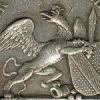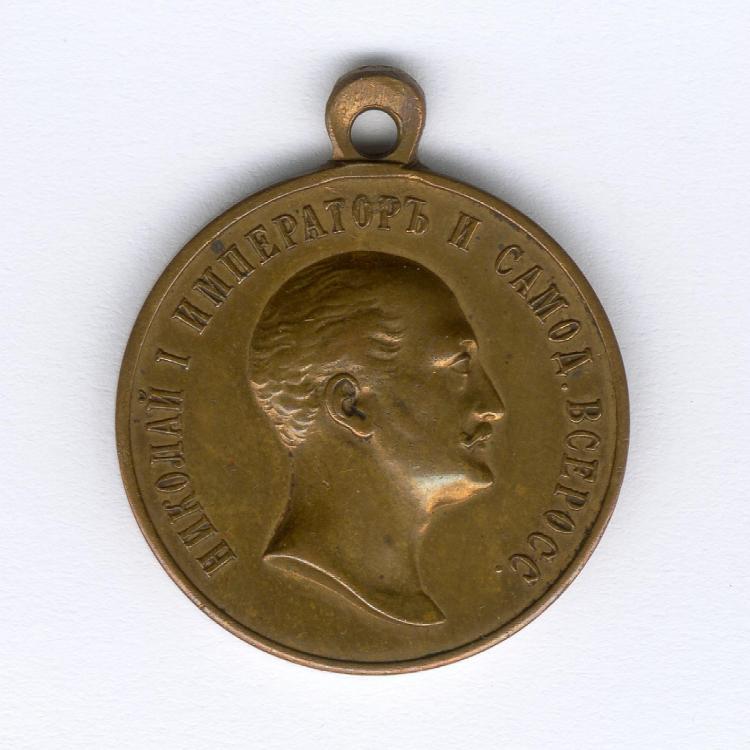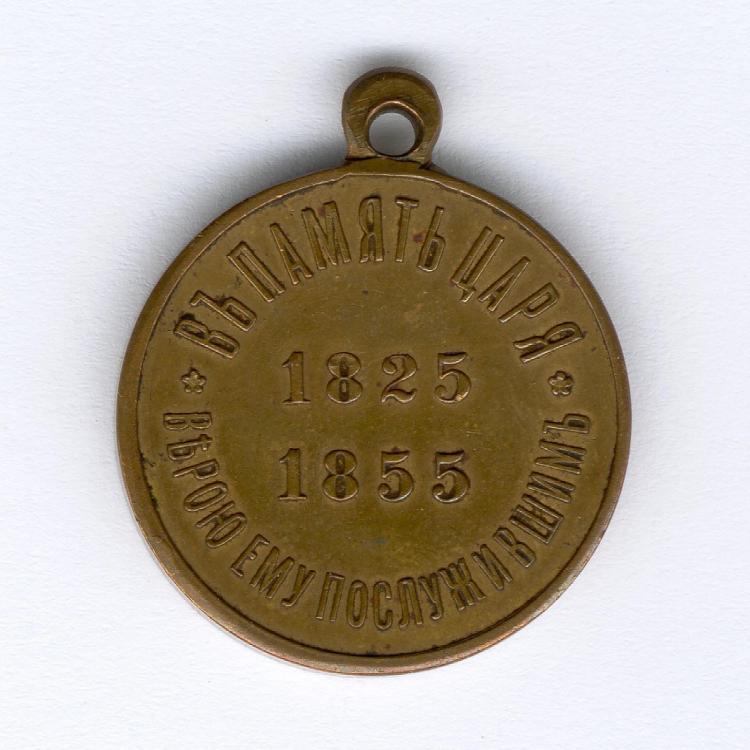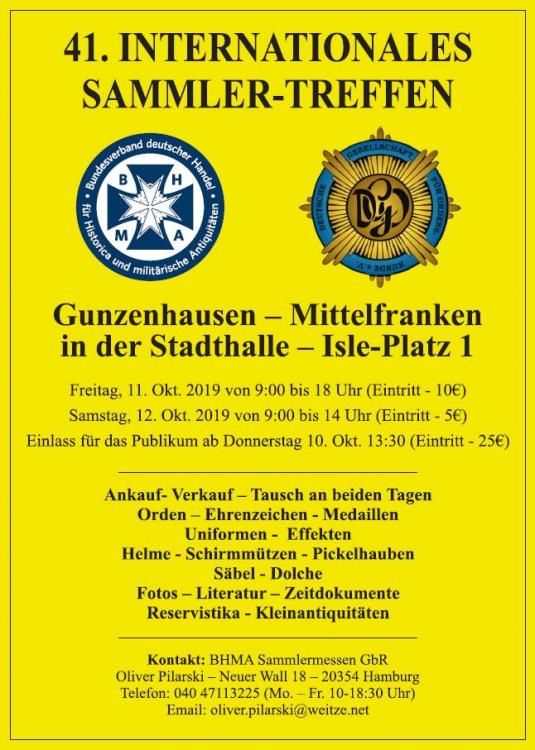-
Posts
3,086 -
Joined
-
Days Won
14
Content Type
Profiles
Forums
Blogs
Gallery
Events
Store
Everything posted by saschaw
-
These two medals are most confusing, and have always been. Even back then, in 1906 ff., there was much confusion, and you will often find them mounted on unfitting ribbons. The medal with inscription on the avers, the Erinnerungsmedaille für 1906, is a jubilee medal, awarded on occurrence of the golden wedding jubilee of the grand duke. The medal without inscription, the Friedrich-Luisen-Medaille, was instituted in 1906 as well, but not as a jubilee medal but for caritative merits. This was awarded for several years, probably until the "Great War" started. Most went to nurses and doctors, but many as well to civil state servants and private persons that supported hospitals, orphanages and such by giving donations to them. The Friedrich-Luisen-Medaille on the 4 place medal bar has the proper ribbon, but the Jubiläumsmedaille on the 3 place medal bar should be worn on the very same ribbon as the 1902 jubilee medal, that can bee seen on the second and third bar you show. Anyway, thanks for sharing! That is a brilliant portrait of Otto Winterer (1846-1915) who was lord mayor (Oberbürgermeister) of the city of Freiburg im Breisgau from 1888 until 1913... it's funny to see how messy he wore his medal bar!
-
I have one as well, and as it came from some old collection, I'm pretty confident it is authentic. But with so many fakes of Tsarist Russian awards around, and my lack of experience in this field, I'd like to ask: Is this an authentic piece? Thank you!
-
Claudius, to avoid confusion, Paul's comment related to the 2014 show... I pushed it up again for the 2019 show, which will take place in now less than two weeks! Thanks for all of your comments - so glad I won't be completely alone there! 1812 Overture, I think I will rather not make it to Beijing show, sorry!
-
As I noted in another thread, it's a bit mean of me to ask almost five years after... The only medal I can find is a golden wedding jubilee of the Prince of Hohenzollern from 1884, but it's a table medal, none intended for wear. See here, lot 1292, for one in silver and here for one in bronze. I don't know but guess it came in gold as well.
-
I would address any "CD 800" cross an award type, other than their "square mark" crosses. What makes (or made?) you believe this - or every "CD 800" - is a private purchase cross?
-
I'm not sure what makes you suggest pre-war? This Royal Hohenzollern House Order is with swords, thus on war ribbon. After the wars of 1866 and 1870/71, there was hardly more than an handful of HOH3X awarded for the colonial and overseas campaigns. Ludvigsen gives a total of six(!) for the years 1896 to 1908. For this lapel bow, I'd suggest late or rather post "Great War" era. The major part of the HOH3X were awarded in the second half of the war, most even in 1918 (see Geile, p. 51). Anyway, this is an unusual combination for sure!
-
Another impressive and most interesting group, thanks for sharing! I don't think he did: The war ribbon was the proper one after the 1913 change of regulations. On bars that were assembled from that point on, you can find MVOs and MVKs with swords on the war ribbon, even if they had been awarded on the older, then peace time ribbon. I'm rather sure this was officially allowed, but cannot prove this time.
-
That's such a great Feldspange with this ultra-rare, but inofficial clasp, Rudi! Trust me, there is really no need for a Wiederholungsspange expert, when our Hessen experts - and all books on the topic! - are clear in this point: The Hessen bravery medal could not be awarded twice. Thus, no need for a Spange. Other than many Austrian-Hungarian "Great War" awards, it was unusual, to say the least, to award the very same award several times in the German states. These beautiful cases for Hessen awards were official. From my understanding, it wasn't about rank. The cases are pre- and early war, and later, when resources got narrow, they switched to envelopes. It was most similar with Baden, where even the lower classes of the Zähringer Löwen order were awarded in sealed envelopes...
-
If you don't mind, I'll re-address the original topic of this thread, the Bavarian tuxedo bar with SMK... one I think that has to be unique, but may still refuse identification? There weren't too many Bavarians to get this SMK, but... as civilians, they're so difficult to trace down. The SMKs are part of the Ernestine volume published by Daniel Krause and Rick Lundström in 2008! Sure you're not having it? If Daniel doesn't have any more of them, Michael Autengruber at orden-der-welt.de might have...
-
The cross shown by Bob Hunter in 2005 is indeed an earlier type: a cross made by Stuttgart court jeweler Eduard Foehr. From 1914 to 1916, Foehr supplied only 331 knight's crosses 2nd class, of which some got older, Steinam made swords that had been removed from returned 1870/71 crosses. For comparison the Stuttgart mint, only supplier of late war awards, produced a total of 4938 knight's crosses 2nd class with swords (see Klein and Raff, p. 466, 467 and 483). But that's a knight's cross 1st class, isn't it? I think I can see the rays between the cross arms...
-
As neither "Prinzengröße" nor "Reduktion" are official terms, there are no actual rules about their sizes. I consider every centenary medal that is significant smaller than the award type a "Reduktion", avoiding the confusing term "Prinzengröße". Please keep in mind those were available for buy to everyone who felt the medal was too big for his medal bar... I think by now, I had at least two of that less usual "medium size".
-

K. A. G. - maker of Iron crosses from Bratislava?
saschaw replied to kasle's topic in Germany: All Eras: The Iron Cross
I do not have any of Konstantin's books, as I could not read a single word по-русски, unfortunately. I'd be very interested to see his explanation and evidence backing this up. But to be frank: I have some strong reservation... That piece of information must be true, to my understanding: As K.A.G. crosses are award types, and awarded 1st class crosses were supplied by the five well known Berlin monopolists only in the first years of the war, K.A. G. crosses must date to mid-1917 and later. Neither have I ever seen documented groups suggesting something else. -
What might also be important to note: Grand Cross badges and Commander crosses are of identical size for this order, and indistinguishable from each other, unless they come with either solid provenience or the breast star, as the latter was worn by Grand Crosses only (see Klein and Raff, p. 454/455). Also interesting: the Grand Cross badge was, as previously noted by Taz, worn on the neck as well. It wasn't until the September 1914 statutes changed that it got a sash, as it's usual for Grand Crosses grades (Klein and Raff, p. 460). I was totally unaware of that fact. I'm sorry for my misleading information in my earlier statement.
-
Komtur, that is a really "rare bird" and a beauty of a medal bar, apparently arranged before 1863 due to the lack of the Erinnerungs-Kriegsdenkmünze... thanks for sharing it with us! Karsten, you're probably right. The Prussian officials discussed the change in April 1885, and it probably took a while until the new style crosses were available and actually handed out. All this is described a bit more in detail in Mike's article... I assume you know it, don't you?
-
According to Mike Estelmann, Die Modellumstellung des Roten Adler Ordens der 4. Klasse von glatte auf gekörnte Kreuzarme – Eine offene Frage findet ihre Beantwortung, published in German DGO magazine Orden und Ehrenzeichen, vol. 83 from February 2013, the change from smooth to pebbled cross arms was in 1885. Other than Mr. Nimmergut and most other German experts, who just estimated their "1879", Mike went through the effort of looking at the actual archive files. And apparently, he was the first one to do so... Just as an addition to this thread, after I've read the "1879" in the header. No offense meant, of course! Well, maybe towards Mr. "medals pope" Nimmergut... Alex, yours is even earlier, and counts to the previous type: crosses with this purple eagle were awarded from 1846 to 1854 only! Plus, Hossauer sold his workshop in 1859, so even a later (still smooth) type with his signature would have to be considered as very early. David, you probably read this in the past years at some other point, but just in case you didn't: All of the Prussian awards, to both Natives and Foreigners, were listed in the officially published Königlich Preußische Ordens-Liste. Only exception is for people that died between the award and the next issue of the mentioned list...
-
Both groups look manipulated to me, and for the larger one, I found an old entry on the forum that proves it. Check here, in the famous "Imperial fakes" thread. If the smaller group came from the same seller, I'd be very confident it has similar problems. It's such a shame authentic groups are destroyed to create half-fake-nonsense-bars, just to increase profit of some nasty dealer...
-

Imperial Russia Red Cross Medal for the Russo-Japanese War 1904-1905
saschaw replied to paja's topic in Russia: Imperial
That's a great and very informative thread, worth being pulled up again! Some of these Red Cross medals were awarded to foreigners as well, I saw especially some to Germans. On ebay, there's acurrently a miniature chain offered that includes this award. The fitting ribbon bar doesn't include the Russian awards, however. It probably dates from the "Great War" period, when many decided not to wear awards from their now-enemies anymore...




